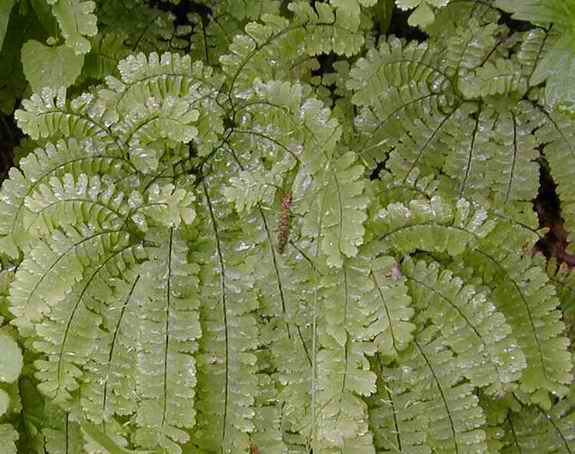|
Return to Hiker's Notebook Home Page
Common Name: Maidenhair Fern, Northern Maidenhair Fern (Five-finger Fern), Southern Maidenhair Fern (Venus-hair Fern, Black Maidenhair Fern). The Northern Maidenhair Fern is pictured above. Scientific Name: Adiantum pedatum - The generic name is derived from the Greek adiantos that means "not wetting" and refers to the characteristic that the frond can shed water without getting wet; pedatum is a Latin word that literally means "ill set on his feet," the foot reference for the five-toed pinnules that resemble a bird's foot. The Southern Maidenhair Fern is Adiantum capillus-veneris, the species name is from the Latin capillus meaning hair and veneris meaning the goddess Venus; literally Venus's hair. The common name maidenhair is a more general term for Venus's hair.
The Maidenhair Fern is one of many plants whose common, vernacular name is attributed to a combined medical and philosophical theory known as the Doctrine of Signatures. The Doctrine was based on the work of Paracelsus, an iconoclast considered the first practitioner of homeopathic medicine in the 16th Century. In breaking from the medical traditions of the age in advocating cures with radical treatments such as mercury for syphilis, he promoted natural medicines. The Doctrine of Signatures was popularized as a Christian theology by Jacob Boehme in "Signatura Rerum" which translates as "The Signature of All Things." Boehme claimed that God would have no knowledge of himself if he did not reveal "himself to himself" (i.e. the world that he created which was therefore, in essence, himself). Thus, the plants of God's Kingdom were given a characteristic appearance as a "sign" that was intentionally provided as a revelation. It was then up to man to ascertain God's intentions and ratiocinate their medicinal or palliative use. Yellow plants were thus signed as good for the spleen, red plants for the heart, green plants for the liver and black plants for the lungs. The Doctrine of Signatures became very popular in the 18th Century when herbalists such as William Cole exaggerated the more modest claims of their predecessors with increasingly extrapolated cures, such as a treatment for the pricks caused by thorns made from a tincture of the twigs of the thorny hawthorn shrub.
The Maidenhair Fern is so named because its roots have fine and delicate hairs, like the hair of Venus. As it thus has the "signature" of hair, it must therefore be "signed" as a treatment for baldness, the maiden's hair taken internally to encourage the recalcitrant hair follicles to rejuvenation. The English herbalist John Gerard (1545-1612) wrote in The Herbal, General Historie of Plants "It consumeth and wasteth away the King's Evil and other hard swellings, and it maketh the haire of the head or beard to grow that is fallen and pulled off."
As was the case with many plants that had medicinal powers attributed to the Doctrine of Signatures (and that they were therefore sanctified by God's presence), the Maidenhair Fern came to be used for many conditions beyond its original intent. Thus, Nicholas Culpepper (1616-1654) wrote in The English Physician "This and all other Maiden Hairs is a good remedy for coughs, asthmas, pleurisy, etc. and on account of its being a gentle diuretic also in jaundice, gravel and other impurities of the kidneys. All the Maidenhairs should be used green and in conjunction with other ingredients because their virtues are weak."
The Maidenhair fern is widely used in modern herbal medicine as a holistic alternative to the standard allopathic remedies. These are generally in keeping with those extrapolated from the original treatment for baldness. There may be some veracity to the claims, as the fern contains tannin and mucilage that are often of medicinal benefit. Its primary historical use in Western medicine has been in the treatment of pectoral complaints. An elixir known as Sirop do Capillaire is made in France from the fronds and used to treat pulmonary catarrhs and other throat afflictions such as coughs. Dried Maidenhair fronds and rhizomes are dried to make a variety of medicines, including a detoxicant for alcoholism, a decoction to expel worms from the body (particularly the ringworm that causes bald spots) and a composition called Elixir of Garus that is taken as an emmenagogue (menstrual flow stimulation) in Europe under the names of polytrichon or kalliphyllon.
Native Americans created a poultice form the chewed fronds of Maidenhair ferns that was applied topically as a styptic to arrest the bleeding from a wound. They may also have applied it to aching joints as a means of easing the pain. The stalks of the Maidenhair fern retain their dark color and pliability after drying. They were thus used by numerous Indian tribes including the Makah, Quinault, Karok and Yurok as a contrasting material in the manufacture of baskets, the dark Maidenhair stalks providing the darker color for the creation of geometrical patterns. |
